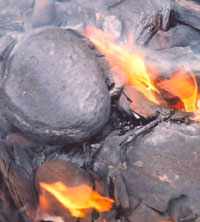Oil Shale
| Sedimentary rock | |

Combustion of oil shale
|
|
| Composition | |
|---|---|
| Primary | |
| Secondary | |
Oil shale is an organic-rich fine-grained sedimentary rock containing kerogen (a solid mixture of organic chemical compounds) from which liquid hydrocarbons called shale oil (not to be confused with tight oil—crude oil occurring naturally in shales) can be produced. Shale oil is a substitute for conventional crude oil; however, extracting shale oil from oil shale is more costly than the production of conventional crude oil both financially and in terms of its environmental impact.Deposits of oil shale occur around the world, including major deposits in the United States. Estimates of global deposits range from 4.8 to 5 trillion barrels (760×109 to 790×109 m3) of oil in place.
Heating oil shale to a sufficiently high temperature causes the chemical process of pyrolysis to yield a vapor. Upon cooling the vapor, the liquid shale oil—an unconventional oil—is separated from combustible oil-shale gas (the term shale gas can also refer to gas occurring naturally in shales). Oil shale can also be burned directly in furnaces as a low-grade fuel for power generation and district heating or used as a raw material in chemical and construction-materials processing.
...
Wikipedia
